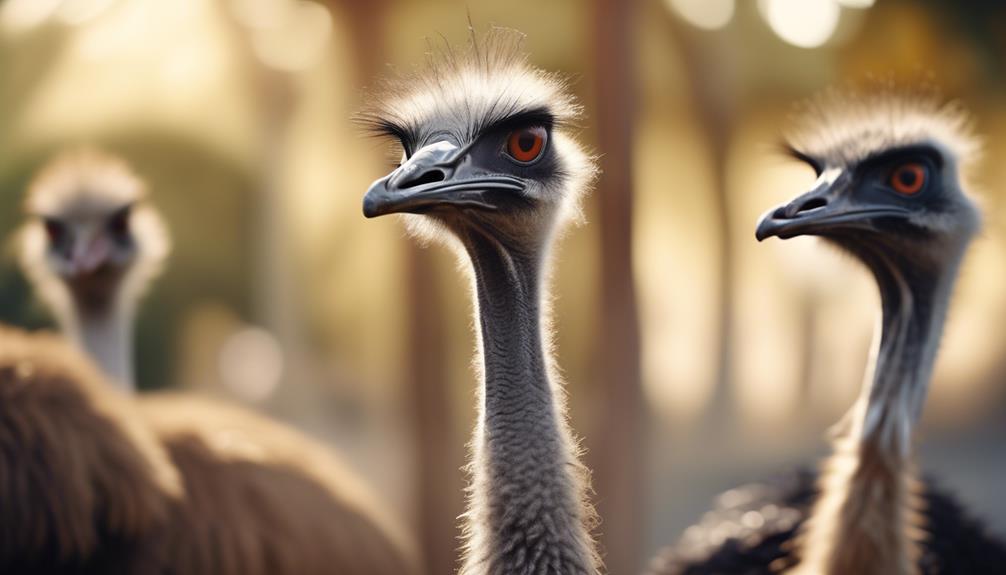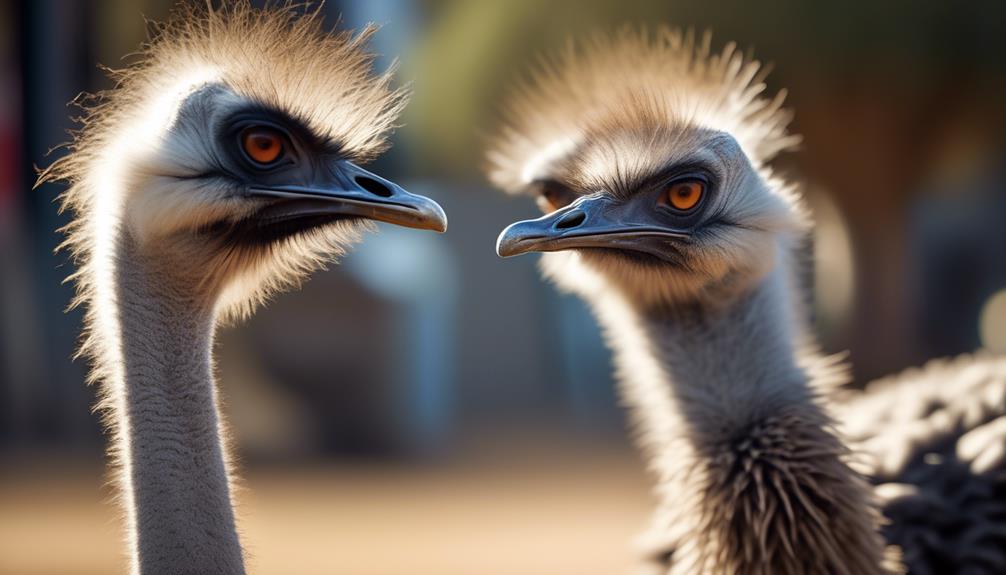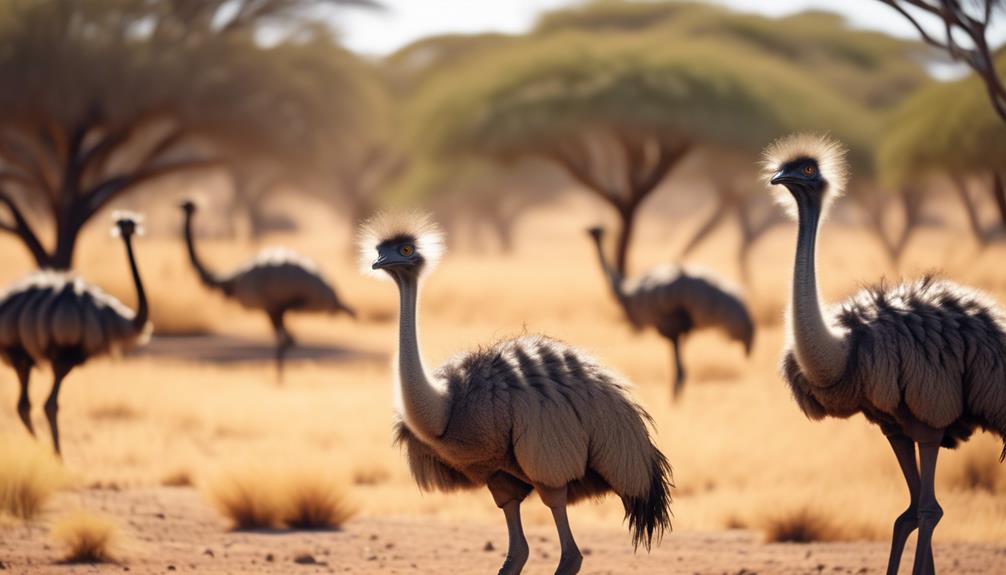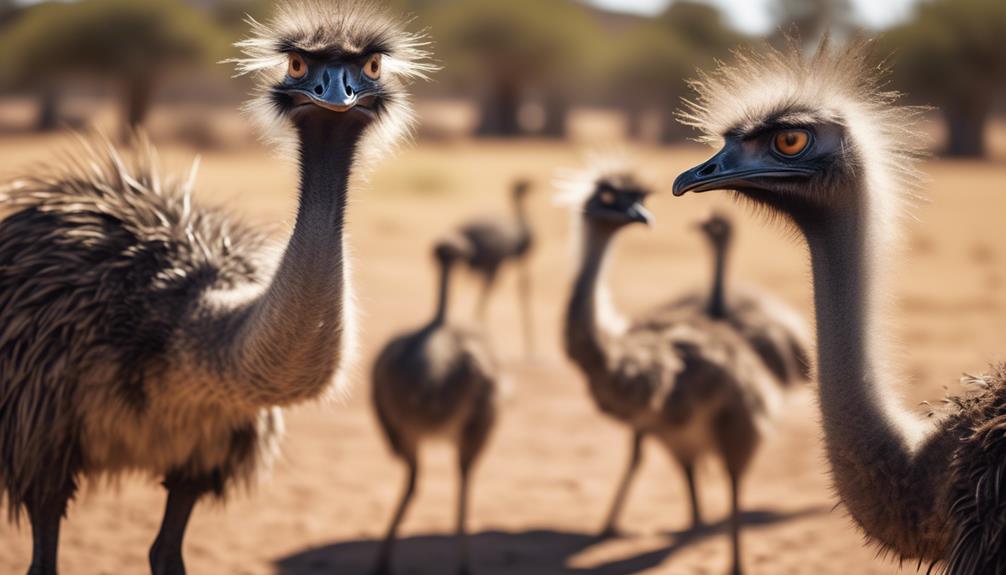
Have you ever wondered about the distinct characteristics that set emus and ostriches apart?
These fascinating flightless birds may seem similar at first glance, but upon closer observation, you'll discover a world of differences.
From their physical attributes to their behaviors and habitats, emus and ostriches exhibit unique traits that make them truly intriguing creatures.
So, let's dive into this captivating comparison and uncover the remarkable disparities that exist between these two remarkable species.
Physical Characteristics

Emus and ostriches differ in their physical characteristics, with distinct features that set them apart from each other. Let's explore their feather structure and beak adaptation.
Feathers are a defining characteristic of both emus and ostriches. Emus have long, coarse feathers that are brownish-black in color. These feathers are made up of two main parts: the shaft and the barbs. The shaft runs down the center of the feather, providing support and strength. The barbs, which are attached to the shaft, have interlocking structures that give the feathers their unique appearance.
Ostriches, on the other hand, have soft and fluffy feathers that are primarily white and gray. These feathers lack the interlocking barbs seen in emu feathers, giving them a more feathery and less structured appearance.
In terms of beak adaptation, emus and ostriches have different adaptations to suit their dietary needs. Emus have a slender beak with a sharp tip, allowing them to forage for a wide range of food, including grass, insects, and small vertebrates. Their beak is also highly flexible, enabling them to grasp and pick up food with ease.
Ostriches, on the other hand, have a robust beak with a flat tip. This adaptation allows them to feed primarily on vegetation, such as leaves, grass, and seeds. The flat beak helps them to efficiently gather and consume plant matter.
Size and Weight
When comparing the size and weight of emus and ostriches, it's evident that there's a significant difference between the two species. Emus, standing at an average height of 5 to 6 feet, are smaller than ostriches, which can grow to an impressive height of 7 to 9 feet. This disparity in height is also reflected in their weight. Emus weigh around 80 to 130 pounds, while ostriches can reach a staggering weight of 220 to 350 pounds.
The differences in size and weight can be attributed to various factors. Firstly, the habitat of these birds plays a role. Emus are native to Australia, where they've adapted to the relatively harsh and arid conditions. Their smaller size allows them to navigate through dense vegetation and thrive in their environment.
Ostriches, on the other hand, are found in Africa's vast open plains, where their larger size provides them with an advantage in terms of visibility and protection from predators.
Another factor influencing the size and weight of these birds is their evolutionary history. Emus and ostriches belong to different genera and have evolved separately over millions of years. This divergence has led to the development of distinct physical characteristics, including differences in size and weight.
Feathers and Plumage

The feathers and plumage of emus and ostriches exhibit distinct characteristics that set them apart from each other. Let's explore the differences in feather patterns and coloration between these two fascinating flightless birds.
- Feather patterns:
- Emus have soft, loose feathers that resemble shaggy fur. These feathers are characterized by a symmetrical arrangement, giving the bird a streamlined appearance.
- Ostriches, on the other hand, possess long and elegant plumes that cascade down their bodies. These feathers, known as filoplumes, are delicate and provide insulation.
- Feather coloration:
- Emus display a predominantly brownish-gray coloration, which helps them blend in with their surroundings, providing camouflage and protection.
- Ostriches exhibit a striking contrast in color, with black feathers on their bodies and white feathers on their wings and tails. This plumage serves as a visual signal during courtship displays.
- Intimacy with nature:
- Imagine running your fingers through the soft, velvety feathers of an emu, feeling the warmth and texture against your skin.
- Picture the mesmerizing sight of an ostrich gracefully fanning its elegant, snow-white plumes, creating a breathtaking display of beauty.
Egg Size and Incubation
In comparing the egg size and incubation process of emus and ostriches, one can observe significant differences. Emu eggs are slightly smaller than ostrich eggs, measuring about 5.5 inches in diameter and weighing around 1.5 pounds. On the other hand, ostrich eggs are the largest of any bird species, with a diameter of about 6 inches and a weight of approximately 3 pounds. The size difference is quite noticeable, with ostrich eggs being almost twice as big as emu eggs.
Apart from size, another notable distinction lies in the color of the eggs. Emu eggs have a dark greenish-blue color, while ostrich eggs have a creamy white hue. These distinct colors serve as camouflage and help the eggs blend into their respective habitats.
In terms of incubation, both emus and ostriches exhibit similar behaviors. The females are responsible for building nests, which consist of a shallow hole in the ground lined with vegetation. However, the incubation period differs significantly. Emu eggs take approximately 50 to 55 days to hatch, while ostrich eggs require a longer incubation period of around 40 to 45 days.
To summarize the differences in egg size and incubation between emus and ostriches, refer to the table below:
| Emu Eggs | Ostrich Eggs | |
|---|---|---|
| Size | 5.5 inches in diameter, 1.5 pounds | 6 inches in diameter, 3 pounds |
| Color | Dark greenish-blue | Creamy white |
| Incubation Period | 50-55 days | 40-45 days |
These variations in egg size, color, and incubation period contribute to the uniqueness of each species and highlight the fascinating diversity found in the avian world.
Habitat and Geographic Distribution

Emus and ostriches have distinct habitats and geographic distributions, reflecting their adaptability to different environments. These fascinating flightless birds have evolved specific adaptations that allow them to thrive in their respective habitats.
Let's take a closer look at their habitat adaptation and climate preferences:
- Emus prefer to inhabit open grasslands and savannas, where they can easily blend in with their surroundings. They're commonly found in Australia, where they've adapted to the dry and arid conditions of the Outback.
- Ostriches, on the other hand, are native to the vast open plains of Africa, including the savannas, deserts, and semi-arid regions. Their long legs and powerful muscles enable them to cover great distances, making them well-suited for running across the expansive grasslands.
Emus are capable of withstanding a wide range of temperatures, from scorching heat to freezing cold. They've developed physiological adaptations, such as a reduced metabolic rate and the ability to store fat reserves, which allow them to survive in extreme climatic conditions.
Ostriches, being native to Africa, have adapted to the hot and dry climates of the continent. They've specialized feathers that help regulate their body temperature. Additionally, they've a unique respiratory system that allows them to cool down by panting, similar to dogs.
Understanding the habitat and geographic distribution of emus and ostriches provides valuable insights into how these birds have successfully adapted to their respective environments.
Diet and Feeding Habits
Having examined the habitat and geographic distribution of emus and ostriches, we can now delve into their distinct diet and feeding habits. Understanding the foraging behavior and digestive system of these flightless birds is crucial in comprehending their differences.
| Emus | Ostriches | |
|---|---|---|
| Foraging | Emus are opportunistic foragers, eating a variety | Ostriches are also opportunistic feeders, consuming a |
| Behavior | of plant matter, fruits, seeds, insects, and small | wide range of food including plants, roots, seeds, and |
| vertebrates. They have a broad diet and can adapt | invertebrates. They are selective feeders, with a diet | |
| to different environments. They have a unique | that changes based on availability and season. | |
| feeding behavior where they use their strong beak | Ostriches can also swallow pebbles and stones, which | |
| to rip off vegetation and swallow it whole. | helps in grinding food in their muscular gizzard. |
The digestive system of emus and ostriches is similar, with both birds possessing a simple stomach and a specialized structure called the gizzard. However, there are some differences in their digestive processes. Emus have a longer small intestine compared to ostriches, allowing for a more efficient absorption of nutrients. Ostriches, on the other hand, have a larger gizzard, enabling them to digest tougher plant material and even small stones. This aids in the breakdown of food and assists in the grinding process.
Social Behavior and Mating

The social behavior and mating patterns of emus and ostriches exhibit distinct similarities and differences. While both species engage in courtship behavior and have unique mating rituals, their approaches differ in several ways.
• Courtship Behavior:
- Emus: Male emus perform elaborate courtship displays that involve puffing out their feathers, dancing, and making rumbling sounds to attract females.
- Ostriches: Male ostriches engage in courtship dances that include wing flapping, head bobbing, and hissing, often accompanied by booming vocalizations.
• Mating Rituals:
- Emus: Emus form monogamous pairs during the breeding season. The male constructs a nest on the ground, and both partners take turns incubating the eggs.
- Ostriches: Ostriches have a polygamous mating system, where males establish territories and mate with multiple females. The females lay their eggs in a communal nest, and the dominant female incubates them while the other females contribute their eggs.
• Social Structure:
- Emus: Emus typically live in small groups or pairs, with a dominant female leading the group.
- Ostriches: Ostriches form larger social groups called flocks, consisting of multiple males, females, and their offspring.
Understanding the courtship behavior and mating rituals of emus and ostriches provides insight into their social dynamics and reproductive strategies. Their distinct approaches to courtship and mating contribute to their unique behaviors and social structures.
Predators and Natural Threats
When considering the ecological roles and survival strategies of these remarkable birds, it is essential to examine the predators and natural threats that impact both emus and ostriches. Understanding the predator-prey dynamics and defense mechanisms of these species provides valuable insights into their evolutionary adaptations and their ability to thrive in their respective habitats.
To compare the predators and natural threats faced by emus and ostriches, let's take a look at the table below:
| Predators | Emus | Ostriches |
|---|---|---|
| Carnivores | Dingoes, eagles, feral cats | Lions, leopards, cheetahs, hyenas |
| Omnivores | Humans, wild pigs | Humans, jackals, baboons, snakes |
| Natural Threats | Drought, bushfires | Drought, heatwaves, diseases |
Emus and ostriches share some common predators, such as carnivorous mammals and birds of prey. Dingoes, eagles, feral cats pose a threat to emus, while lions, leopards, cheetahs, and hyenas are known to prey on ostriches. Both species also face the risk of predation from omnivores, including humans. Human activities, such as hunting and habitat destruction, have significantly impacted their populations.
In addition to predation, both emus and ostriches face natural threats in their environments. Drought and bushfires pose a significant risk to emus, while ostriches are particularly vulnerable to drought, heatwaves, and diseases.
These predator-prey dynamics and natural threats have shaped the defense mechanisms of emus and ostriches. Emus, for example, have strong legs and can run at high speeds to evade predators. They also have sharp beaks that they can use for defense. Ostriches, on the other hand, rely on their powerful legs, capable of delivering lethal kicks, to deter predators. Their large size and strong beaks also serve as formidable defensive tools.
Lifespan and Reproduction

Emus and ostriches exhibit distinct differences in their lifespan and reproductive patterns. When it comes to longevity, emus have been known to live up to 10-20 years in the wild, while ostriches can surpass this with a lifespan of 30-40 years. These differences in longevity can be attributed to various factors, including genetics, diet, and environmental conditions.
In terms of breeding patterns, emus and ostriches also differ significantly. Emus are polygamous, meaning that one male mates with multiple females during the breeding season. The male emu takes on the responsibility of incubating the eggs and caring for the chicks once they hatch.
On the other hand, ostriches are also polygamous, but with a different twist. In ostrich societies, one dominant male mates with multiple females within a harem, while other males are excluded from breeding. The dominant male guards the nest, and the females take turns incubating the eggs.
Conservation Status and Human Interaction
Emus and ostriches have notable differences in their conservation status and the ways in which humans interact with them. While both species face various threats, including habitat loss and hunting, their conservation efforts and the impact of human activities differ significantly.
Let's take a closer look at the conservation status and human interaction with emus and ostriches in the table below:
| Emus | Ostriches | |
|---|---|---|
| Conservation Status | Least Concern | Vulnerable |
| Human Impact | Controlled farming and hunting | Commercial farming and illegal hunting |
Emus are currently classified as "Least Concern" by the International Union for Conservation of Nature (IUCN), indicating that their population is stable. Conservation efforts for emus mainly focus on maintaining their habitats and preventing illegal hunting. Emus are also commercially farmed for their meat, oil, and feathers, providing a sustainable source of income.
On the other hand, ostriches are classified as "Vulnerable" due to a declining population. Their conservation efforts primarily revolve around protecting their habitats, raising awareness about their conservation status, and implementing sustainable farming practices. However, ostriches face additional threats from illegal hunting, driven by the demand for their feathers and eggs.
Understanding the differences in conservation status and human interaction with emus and ostriches is crucial for developing effective conservation strategies and ensuring the long-term survival of these fascinating birds.
Frequently Asked Questions
Do Emus and Ostriches Have Any Natural Predators?
Do emus and ostriches have any natural predators? Yes, they do. Both species face threats from predators such as lions, cheetahs, and hyenas. However, their large size and speed help them defend themselves and their nests.
How Do Emus and Ostriches Communicate With Each Other?
Emus and ostriches communicate with each other through a combination of vocalizations and body language. They use visual displays and dances to convey messages and establish dominance. These behaviors play a crucial role in their social interactions and mating rituals.
Are Emus and Ostriches Able to Fly?
Emus and ostriches, the flightless birds, possess impressive long legs but lack the ability to fly. These magnificent creatures, like you, are grounded. Soar in your own unique way, just as they do on land.
What Are the Primary Threats to Emus and Ostriches in Their Natural Habitats?
In their natural habitats, both emus and ostriches face primary threats from human encroachment and habitat loss. These factors disrupt their ecosystems, leading to a decline in their populations and compromising their survival.
Can Emus and Ostriches Be Kept as Pets?
Emus and ostriches can be kept as pets, but there are pros and cons to consider. Emus are more docile and easier to handle, while ostriches are larger and require more space.
Conclusion
In conclusion, while both emus and ostriches are flightless birds with similar physical characteristics, they possess distinct differences.
Emus have a darker plumage and are slightly smaller than ostriches.
Ostriches, on the other hand, have larger eggs and a longer incubation period.
Their habitats and geographic distribution also differ, with emus found mainly in Australia and ostriches in Africa.
Overall, these fascinating creatures showcase unique adaptations and behaviors that contribute to their survival in their respective environments.




